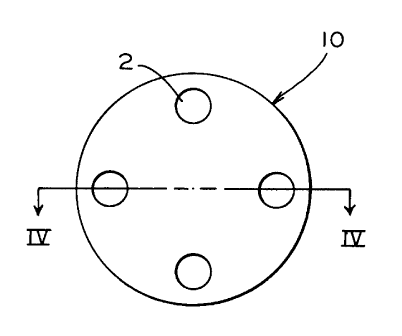Note: Claims are shown in the official language in which they were submitted.
I claim:
1. A diaphragm member for use in certain valve
assemblies, said diaphragm member comprising:
(a) a generally circular diaphragm having a first
predetermined diameter and having a first surface and a second
surface, said generally circular diaphragm formed from at least
one layer of a preselected elastomeric material, said generally
circular diaphragm including:
(i) a nonflexing center portion ,
(ii) a generally annular flexure portion extending
around an outer periphery of said nonflexing center
portion, and
(iii) an outer portion extending around an outer
periphery of said generally annular flexure portion engageable
with a body portion of such valve assembly; and
(b) a generally circular, nonflexible insert member,
having a second predetermined diameter, disposed within said
first surface of said nonflexing center portion of said
generally circular diaphragm, said generally circular insert
member having a plurality of apertures formed through said
generally circular insert member, said plurality of apertures
providing a predetermined open area for receiving a preselected
elastomeric material for bonding said generally circular,
nonflexing insert member to said nonflexing center portion of
said generally circular diaphragm.
8
2. A diaphragm member for use in certain valve
assemblies, according to claim 1, wherein said plurality of
apertures on said generally circular insert being disposed
closely adjacent an outer periphery.
3. A diaphragm member for use in certain valve
assemblies, according to claim 1, wherein said plurality of
apertures on said generally circular insert being disposed on
an axis that is concentric to said outer periphery.
4. A diaphragm member for use in certain valve
assemblies, according to claim 3, wherein said plurality of
apertures on said generally circular insert being spaced
generally equidistant from each other.
5. A diaphragm member for use in certain valve
assemblies, according to claim 1, wherein said plurality of
apertures in said generally circular insert is four.
6. A diaphragm member for use in certain valve
assemblies, according to claim 1, wherein said generally
circular insert is molded within said diaphragm.
7. A diaphragm member for use in certain valve
assemblies, according to claim 1, wherein said generally
circular insert is one of a metal and a metallic alloy.
9
8. A diaphragm member for use in certain valve
assemblies, according to claim 7, wherein said generally
circular insert is
brass.
9. A diaphragm member for use in certain valve
assemblies, according to claim 1, wherein said preselected
elastomeric material is selected from rubber, synthetic rubber
and plastics.
10. A diaphragm member for use in certain valve
assemblies, according to claim 9, wherein said preselected
elastomeric material further includes fabric reinforcement.
11. A diaphragm member for use in certain valve
assemblies, according to claim 10, wherein said fabric
reinforcement is nylon.
10
